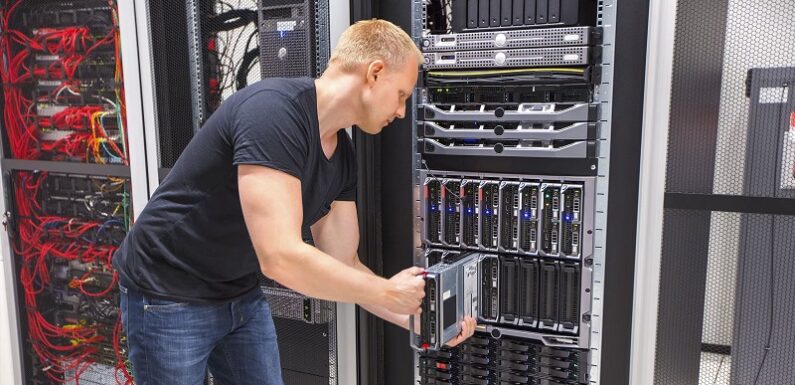
In the realm of IT infrastructure, servers play a pivotal role in supporting and delivering various services, applications, and data to users. Among the numerous server types available, blade, rack, and tower servers are some of the most commonly used options. Each of these server types has its own unique set of advantages and characteristics that cater to specific business needs. In this article, we’ll delve into the differences between blade, rack, and tower servers, helping you understand their distinct features and use cases.
Unlocking Excellence in Server Solutions: Introducing Server Store, Your Dell and HPE Destination
Are you in pursuit of cutting-edge Dell and HPE Servers? Your quest concludes at Server Store, a distinguished subsidiary of Comprint Tech Solutions. Immerse yourself in an all-encompassing realm tailored to cater to your HPE and Dell Server needs. Embark on a journey of innovation and reliability with us.
Blade Servers
Blade servers are a remarkable innovation that aims to optimize space, power, and management within a data center environment. They are designed to be compact and highly modular, making them ideal for organizations looking to maximize their server density. Blade servers are typically housed in blade enclosures, which act as chassis containing multiple blade slots. Each slot can accommodate a blade server module.
One of the key advantages of blade servers is their efficient use of space. By sharing common power supplies, cooling systems, and networking components within the enclosure, blade servers can significantly reduce the physical footprint required for a large number of servers. This consolidation results in better space utilization and easier cable management.
Blade servers also excel in terms of centralized management. The shared components within the enclosure allow for streamlined administration and remote monitoring. However, the initial investment for blade server infrastructure can be relatively high due to the cost of blade enclosures and interconnects.
Rack Servers
Rack servers are a more traditional form of server deployment and are commonly found in data centers and server rooms. These servers are designed to be mounted within standard server racks, which are standardized frames with multiple vertical slots for sliding in servers. Rack servers are known for their versatility, as they come in various form factors and configurations to cater to different performance requirements.
One of the primary advantages of rack servers is their flexibility. Organizations can choose servers that match their specific computing needs, ranging from entry-level models to
high-performance machines. Additionally, rack servers offer a balance between density and scalability. While they may not reach the same level of density as blade servers, they can still be efficiently packed into rack cabinets to optimize space.
Rack servers can be more cost-effective than blade servers in terms of initial investment, making them a popular choice for businesses that require a mix of performance and value. However, cable management can become complex as the number of rack servers increases, and the potential for heat buildup within racks might necessitate additional cooling measures.
Tower Servers
Tower servers stand apart from blade and rack servers due to their physical design. Instead of being rack-mounted or enclosed in blade chassis, tower servers resemble traditional desktop computer towers. This design makes tower servers suitable for small businesses, remote offices, and environments where space constraints are less critical.
The key advantage of tower servers is their simplicity and ease of deployment. Since they do not require special racks or enclosures, tower servers can be conveniently placed on the floor or a desk. They are also straightforward to set up and maintain, making them an attractive option for businesses with limited IT resources.
Tower servers are particularly well-suited for scenarios where only a few servers are needed. However, as the server count increases, space consumption can become a concern. Scaling up with tower servers might eventually lead to challenges related to space efficiency and cable management.
Choosing the Right Server Type
The choice between blade, rack, and tower servers ultimately depends on the specific requirements of your organization. Here’s a quick recap of their main characteristics:
Blade Servers: Ideal for data centers with limited space, high-density computing needs, and centralized management. They excel in consolidating resources and reducing physical footprint. However, the initial investment can be higher.
Rack Servers: A versatile option suitable for various performance levels and budgets. They strike a balance between density and scalability. Rack servers are cost-effective and come in a wide range of configurations.
Tower Servers: Suited for small businesses, remote offices, and environments with space constraints. Tower servers are easy to deploy and maintain but might not be as space-efficient at larger scales.
Before making a decision, consider factors such as the available physical space, scalability requirements, budget constraints, and management capabilities. It’s also advisable to consult with IT professionals who can provide insights based on your organization’s unique needs.
In conclusion, blade, rack, and tower servers cater to different aspects of server deployment. Understanding their differences and capabilities will empower you to make an informed decision that aligns with your organization’s IT goals. Whether you’re aiming for high density, scalability, or simplicity, there’s a server type that can meet your specific needs and contribute to the efficiency of your IT infrastructure.


